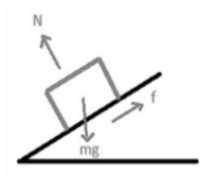Work is the product of force and displacement. Energy is the capacity of doing work. Energy is defined as the product of power and time. Work and energy have the same units kg.m2/s2. The SI unit of work and energy is Joule.
Work energy theorem
Work energy theorem states that work done by the net force acting on a body is equal to the change produced in the kinetic energy.
It can simply be written as W = kf – ki.
The above equation is called the work energy theorem equation.
If kinetic energy of the body decreases, net work done W becomes negative. In other words, we can say that when an object slows down, negative work has been done on that object.
For example, A person is driving a car at high speed and he slows it down and reaches his destination during his journey, firstly at high velocity it will acquire high K.E. In the final part of his journey he attains low velocity and acquires low K.E. Since work done in this journey is represented by the change in its kinetic energy which will be negative.
Consider the following figure,
![]() Derivation of work energy theorem for a constant force
Derivation of work energy theorem for a constant force
Suppose a body having mass m and a constant force is acting on it. It produces an acceleration a. After travelling some distance s, the velocity of the body changes from u to v.
From the third equation of motion,
We have, v2 = u2 + 2as
v2 – u2 = 2as
Multiplying both sides in the equation by ½.m, we get
½.mv2 _ ½.mu2 = m.a.s
Using Newton’s second law, F = ma
½.mv2 – ½.mu2 = F.s
Kf – ki = W
Or,
Change in K.E. of the body = work done on the body by the net force
In this way, we proved that work done on the body is the change in its kinetic energy.
Work energy theorem for a variable force
Suppose a variable force F is acting on a body of mass m and produces displacement ds in its own direction
The small work done given by
dW = F.ds = F.ds cos0 = F.ds
According to the Newton’s second law of motion,
F = ma = m.dv/dt
Therefore , dW = m (dv/dt).ds
= mv.dv (ds/dt = v )
If the applied force increases the velocity from u to v, then the total work done on the body will be
W =dW
= uvmvdv
= muvvdv
=1/2.mv2 – ½.mu2
W = Kf – Ki
= change in kinetic energy of the body
In this way, we have proved the work energy theorem for a variable force.
Examples of work energy theorem related to Real life
Example 1: A car having a mass of 1200 kg having velocity of 25 m/sec. Brakes are applied to it over a length of 60 metres. What is the force applied in this process ?
Ans. ΔK.E = kf – ki
= 0-12120025
= – 150000 J
W = 15000
(F)(50) = -15000
F = – 300 N
Example 2: If the same car is to be brought to rest from a velocity of 80 m/s and the same braking force is applied, how far will the car travel before it stops?
Ans. Δ K.E. = 0 – 121200(80)
= – 48000 Nm
W = -480000
(-300)(d) = – 48000
d = 160 m
Some important points
- The work energy theorem holds in all inertial frames. It can be extended to non inertial frames provided we include the pseudo force in the calculation of the net force acting on the body under the consideration
- When a body moves along a circular path with uniform speed, there is no change in its kinetic energy. By the work energy theorem,since the kinetic energy is unchanged then the work done by the centripetal force on any body will be zero.
- When force and displacement are in the same direction, the kinetic energy of the body increases. The increase in the kinetic energy of the body is equal to the work done on the body.
- When force and displacement are oppositely directed, the kinetic energy of the body decreases. The decrease in the kinetic energy of the body is equal to the work done by the body against the retarding force.
- The work energy theorem is dependent on Newton’s second law. It is taken as the scalar form of the second law.
Conclusion
From the above calculations, it has been proved that the total work done by the body is change in its kinetic energy. The work energy theorem tells us whenever there has been a change in the kinetic energy, the work is said to be done on the body.
 Profile
Profile Settings
Settings Refer your friends
Refer your friends Sign out
Sign out





